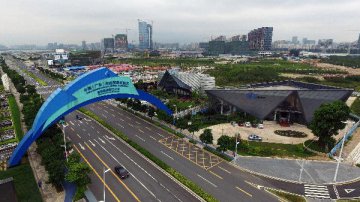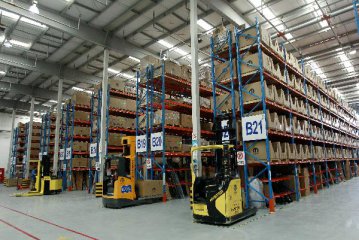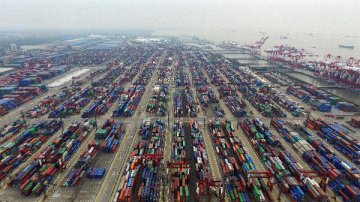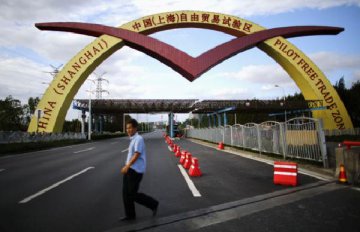
Without the Shanghai Pilot Free Trade Zone, U.S. food quality certification firm Anchor Center for Certification (ACC) would have struggled to enter the Chinese market. ACC filed its registration documents with Shanghai FTZ at the end of June last year, and received its license 15 days later.
Its FTZ office opened for business in March. Stella Si, executive president of the Shanghai firm, attributed the smooth process to the negative list for investment management, which scrapped requirements for foreign certification firms like ACC, and simplified approval procedures.
The negative list model adopted at the Shanghai FTZ is basically a blacklist defining sectors and businesses that are off limits to foreign investment. The FTZ is a testing ground for new policies to facilitate investment and trade, characterized by bolder measures and wider opening up.
Since the Shanghai FTZ was launched on Sept. 29, 2013, 10 other provincial regions now have FTZs.Three FTZs opened in Tianjin Municipality, and Fujian and Guangdong provinces, in April 2015. On Aug. 31, seven new FTZs in the provinces of Liaoning, Zhejiang, Henan, Hubei, Sichuan and Shaanxi as well as Chongqing Municipality were approved.
The number of items on the Shanghai FTZ's negative list has reduced from 190 in 2013 to 139 in 2014, and to 122 in 2015. Trials are aimed at bringing standards in line with international rules and new supervision systems have prompted revision of regulations.
A Boehringer Ingelheim Biopharmaceuticals (China) plant is involved in a pilot Contract Manufacturing Organization (CMO) project on new medicines of innovative small and medium-sized firms.
The facility will begin a trial operation period in Shanghai FTZ in the first quarter next year. Luo Jiali, general manager of the company, said three years ago he was doubtful about the CMO project, but the results of the pilots have reassured him. Foreign investment has seen rapid growth in the FTZs thanks to the reforms.
More than 5,500 foreign-invested enterprises have been set up in the Shanghai FTZ over the past three years, each boasting average registered capital of 15 million U.S. dollars. The contracted foreign investment of the FTZ accounted for 30 percent of Shanghai's total foreign investment in 2014.
This rose to 60 percent last year and 66 percent in the first half of this year, according to Shanghai Commerce Commission. In the first seven months of 2016, 5,783 enterprises were set up in the four FTZs by foreign investors and those from Taiwan, Hong Kong and Macao, securing inbound investment of 7.2 billion U.S. dollars, a year-on-year increase of 66.3 percent, according to the Ministry of Commerce.
In early September, China's top legislature revised four laws regulating inbound investment. The revisions, which will take effect on Oct. 1, suspends administrative approvals for foreign and Taiwanese investors setting up ventures regulated by the four laws, following successful trials in four FTZs.
TRADE FACILITATION
Trade facilitation is another area of progress in China's FTZs.
In early September, the customs clearance time for imported garments only took three hours and 40 minutes, creating a new record for airborne logistics within the Shanghai FTZ. Thanks to 31 new supervision rules, the average customs clearance time at the Shanghai FTZ for inbound and outbound cargo has been reduced by 78.5 percent and 31.7 percent compared with that outside the FTZ. The overall costs for customs clearance were reduced by about 30 percent and the time reduced substantially in Tianjin, Hebei and Beijing after customs services for the three places were integrated.
The average customs clearance efficiency in the four FTZs was enhanced by about 40 percent, said Commerce Minister Gao Hucheng. NEW MAP OF OPENING UP The newly-approved FTZs have different emphases. Liaoning Province in northeast China, for example, will focus on market-oriented reforms to make the old industrial base more competitive. The northeastern region is in urgent need of opening up and the FTZ in Liaoning will play a key role in this regard, said Chi Fulin, director of China Institute for Reform and Development.
Hubei will focus on the high-tech sector and support the development of the Yangtze River Economic Belt, while the FTZs in Chongqing, Sichuan and Shaanxi, all in the less developed west, will help develop the regions.
Chongqing FTZ will be an inland hub for service trade and international logistics, said Mayor Huang Qifan. The FTZs are a symbol of the new round of opening up, featuring more emphasis on an open and improved market economy, especially in terms of rules, said Tong Jiadong, head of the China FTZ Research Center at Tianjin-based Nankai University.
Over the past three years, the FTZs have helped transform government functions, enhanced efficiency and formed a law-based market economy environment, said Tong, who is also vice president of Nankai University. Tong's remarks have been echoed by various domestic and foreign research institutions or firms.
Some foreign enterprises expect the negative list to be shortened further and differentiated opening of some fields such as cloud computing. The opening of the financial sector in China's FTZs still lags behind typical international FTZ practice, said Tong. "To liberalize trade, investment and finance is a typical function of FTZs, and we still have more to do in this aspect," he said.























Latest comments